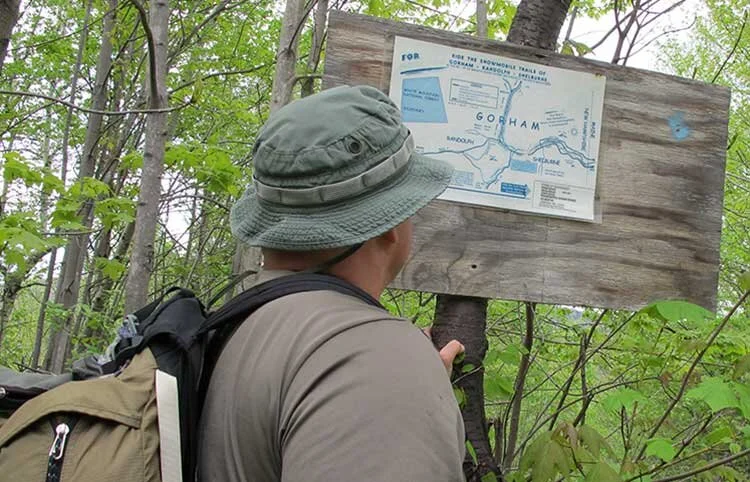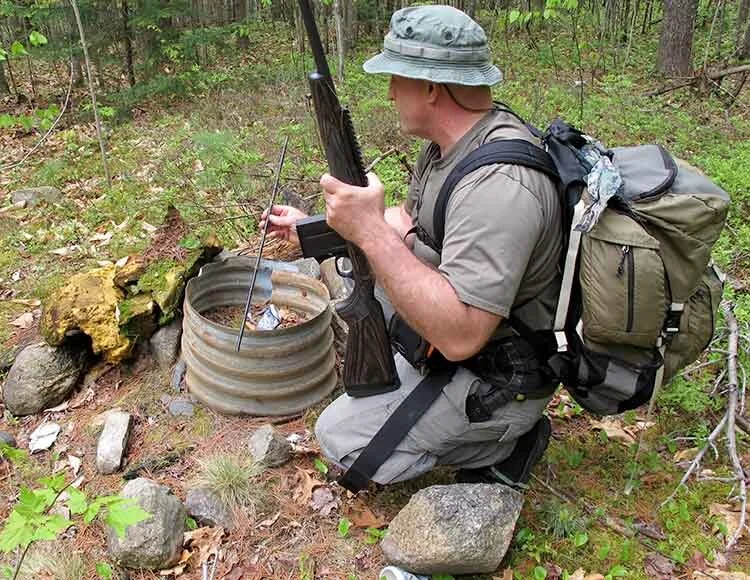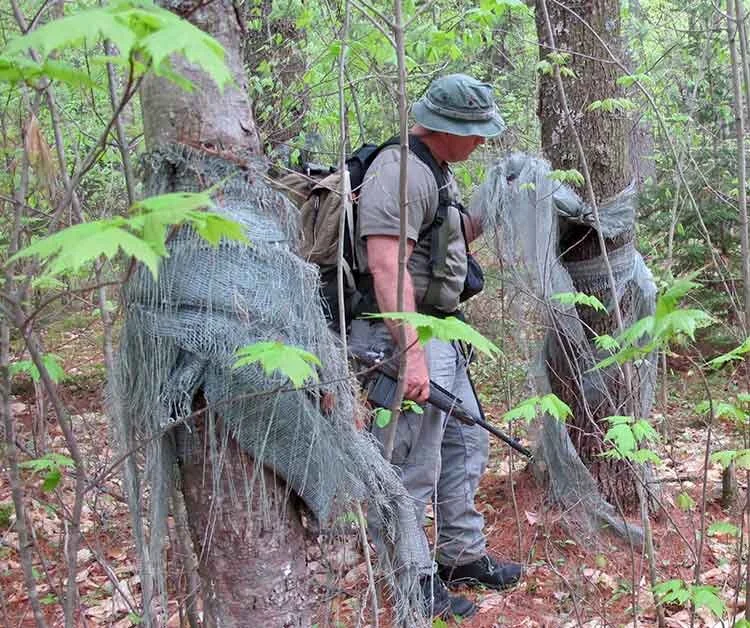mount surpise scout 2
Today I decided to explore more of the lower elevations on the north slope of Mount Surprise just one gully east of the camp I discovered a few days ago.
On this trip I parked my truck on a pull-off from Route 2 in Shelburne just east of the Town and Country Motor Inn. Then I walked perhaps 100-yards uphill on an abandoned ski slope to the Portland Maine to Montreal Canada natural gas pipeline. This underground pipeline is a wide swath through the north country kept clear of trees and vegetation by mechanical cutting done every several years. Electrical powerlines also follow much of its length.
During the 1970’s I lived nearby as a teenager and frequently walked along the pipeline. Instead of cutting off the vegetation using machines and manpower, the pipeline company would spray chemicals from aircraft. In the course of one day all the green leaves would be dead and a bitter, pungent smell hung in the air. Agent Orange? A likely choice.
Conditions:
Temperature 60 to 70 degrees F
Partly sunny
Deciduous leaves still coming out
Black flies and mosquitoes becoming more bothersome
Forest cover: semi-sparse, perhaps at 25%.. Areas of conifers and intermittent conifer trees provide some cover.
Human Contact
Old campsites
Hunters baiting area from last Fall hunting season
Low flying military aircraft
In many places the pipeline makes for easier travel than attempting to negotiate the thick jungle-like forest that grows in the Great North Woods and so the right-of-way is often walked upon by hunters and driven by all terrain vehicles and snowmobiles. The pipeline does travel through swamps that a person would have difficulties getting through in summer (though in winter these areas would be frozen over) and under streams that may not be fordable during periods of high water.
Where the ski slope intersects the pipeline is this sign posted by a snowmobile club. Besides my love of maps, maps made by the locals for areas they are intimate with can yield valuable information that is missing from maps put out by government agencies (such as USGS topographic maps) or large private organizations such as the Appalachian Mountain Club.
Locally made maps can be worth much more than gold: they can mean survival itself, so when you come upon such a map be sure to document it for future reference by taking a picture or obtaining a copy for yourself.
Once on the pipeline I walked west for about 1/4-mile to a point where I would find the second gulley I knew about.
As you can see in the picture, walking on the pipeline creates an exposed position. The town of Gorham is straight ahead about 3/4 of a mile, the Town and Country Motor Inn is just to my right and down hill through a thin layer of trees. At any moment someone walking on the opposite slope of a hill could suddenly appear. An aircraft could easily see you from above. Or even someone located on a nearby hill or mountain looking down.
At a point along the pipeline I thought advantageous, I took a 90-degree turn to the left and merged into the forest where I soon encountered a small gulley running parallel to the one I explored a few days before.
Walking up this gully, which apparently was also once a road of sorts, perhaps for the farm that was on this hill during the 1800’s, I came upon the east end of a low stone wall that went west several hundred yards before petering out.
Upon reaching the stonewall, I heard the distinct sounds of a truck on the pipeline right of way and the closing of its door. Then an ATV, the whine of a chainsaw, and a dog barking.
What this means is this: had I been walking down the pipeline at that time, these people would have suddenly driven up and saw me.
That area is often used by firewood thieves to harvest trees in the age old method of hit and run. Drive into the forest just off the road, saw down a couple hardwood trees and throw the logs in back of a pickup truck. Done.
Firewood is expensive. Let the other guy grow it on his property, then take it for free.
Just downhill from the stonewall I saw what appeared to be a yellow colored boulder that stood out. Upon investigation I discovered this to be a chunk of hard foam, which I recognized as likely being from one of those hunting targets that can be purchased for archery practice.
Many hunters hunt with bow and arrow and someone likely carried a foam target in the shape of a deer or bear to use for ranging their stand. Finding this foam meant there was likely yet another hunting camp nearby.
And there is was – just few yards uphill from the stonewall is another camping spot. This one sports the end of a metal culvert being used as a fire ring. It was likely stolen from a pile of culverts that are being stored along the pipeline right of way below. In the fire ring are the ubiquitous beer cans (don’t you feel safe during hunting season?).
Scattered all over the area are bits of that hard yellow foam material, some of it sprouting a good growth of moss which indicates it has likely been here several years. The beer cans are also substantially faded.
Suddenly and with little warning three large cargo type military aircraft passed nearly directly above me, about 100-feet above the ground. In a line and about 5-seconds apart, the noise was deafening. Fumbling for my camera, I took a picture but the camera was too slow to get the scene in time, so all that was captured in the photo was the forest canopy.
The rural Gorham NH airport is located in line with the direction the aircraft flew and about 2-miles away. That must have been where the aircraft were headed to land. From time to time the military uses these mountains for exercises and over the years I have seen aircraft in the skies and troops on the ground.
Later back home I did some research, the aircraft I saw may have been C-27j Spartans. I had a good look at their underbellies.
I ducked underneath a tree from the direct sight of the planes.
Was I seen? Difficult to know. It is still early spring here in the Great North Woods and only perhaps 250% of the forest canopy has leaf cover.
Just ahead of me attached to several trees were many yards of old, crumbling camouflage fabric that the hunters had attached years ago. As an experiment I decided to see what I could do with it.
The trees had grown right into the fabric, so using my knife I cut off whatever lengths I could. A portion of the netting tended to crumble into almost dust but enough remained to use.
By placing the netting around parts of my backpack that would accept it, and sticking the stems of various bits of vegetation into the netting, it was apparent that with work a serviceable ghillie suit could be made.
The vegetation I used consisted primarily of:
Leaves from a beech tree.
Dry dead leaves from the forest floor.
Blueberry bushes.
I discovered the blueberry bushes worked the best in camouflaging features on my body and gear. I think it has something to do with the 3-dimensional depth of these shrubs and their myriad of tiny green leaves. In addition, the blueberry bushes did not quickly wither as did the beech leaves. This has promise and deserves further experimentation.
I then followed the old stonewall west to its end several hundred yards from its beginning. Huge pine trees 3-feet thick and probably 100-feet tall show how long ago this land was a farmers field.
Then I headed south, toward the location of the hunters bear baiting station I discovered on a previous outing. I wanted to see if anything had changed and, sure enough, the bear had been back digging in the bait stump.
Continuing south another couple hundred yards I cut a logging road that was built in the early 1980’s. Weeds growing on the road show it has not been used by vehicular traffic for quite some time.
From this road I turned back and bushwhacked back down the mountain and toward the abandoned ski slope and my truck.
Upon arriving at the truck, I drove to the Gorham airport hoping I could get some pictures of the large military transport planes that had buzzed me several hours earlier. Alas, the rural airport was empty of planes. Signs prohibiting trespass stopped me from getting this picture.
I hadn’t really thought about it before, and I learned something:
If your area of operations is in line with a nearby airport, you may very well experience low flying aircraft buzzing your position! Even a rural, rarely used airport can host military traffic.
Key takeaways:
Avoid open exposed areas: even if an easy open area is available, you are better off traveling through thick vegetation to remain unseen.
Human castoffs can often be re-purposed into valuable gear.
Local maps made by local people can provide additional information not available from other sources.
When making a ghillie suit, choice of vegetation is a key component.
Avoid travel through areas in direct line with nearby airports. If you must, go through the area quickly and with a maximum of cover.












